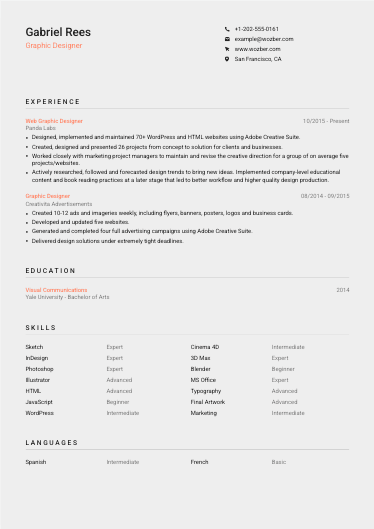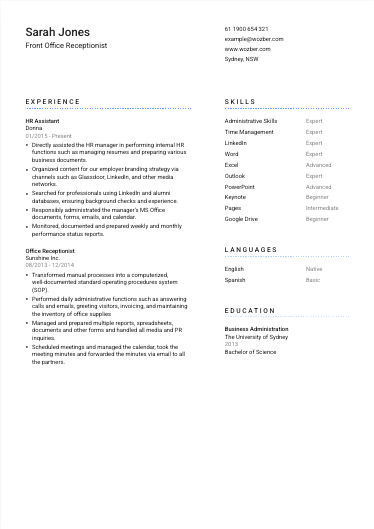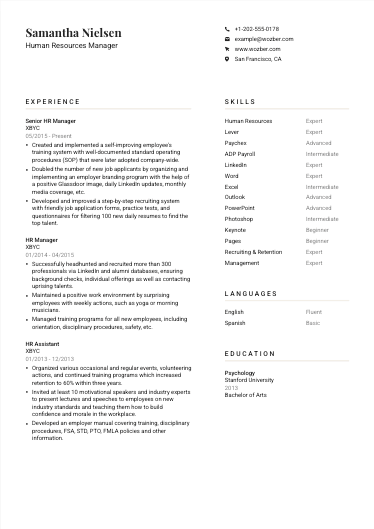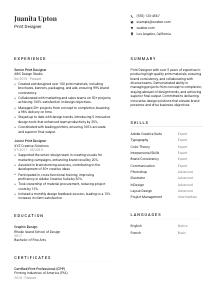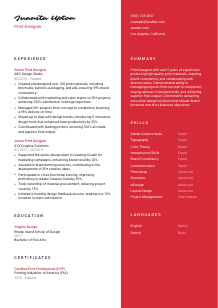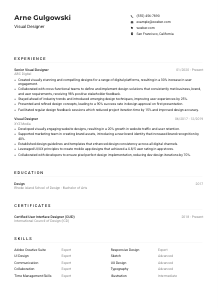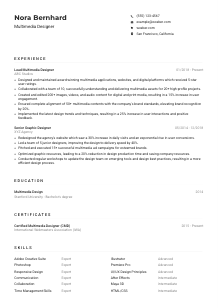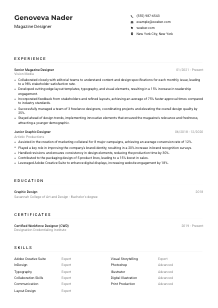Print Designer CV Example
Splashing creativity, but your CV feels grayscale? Dive into this Print Designer CV example, crafted using Wozber free CV builder. It illustrates how you can blend your colors and compositions to target design job requirements, setting your career portfolio on a palette as vibrant as your imagination!
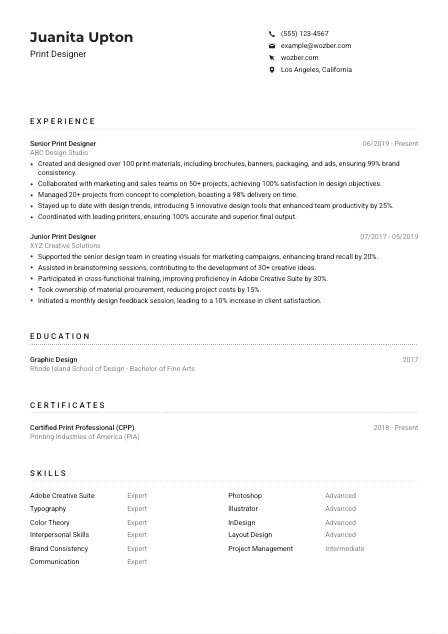
How to write a Print Designer CV?
Embarking on the journey to landing your dream Print Designer role? Your CV isn't just a piece of paper—it's your personal art gallery, showcasing your design prowess and detailing the unique blend of your skills, experience, and creativity. Leveraging the power of the Wozber free CV builder, this comprehensive guide will walk you through creating a CV that not only meets job requirements but shines in the pile. Let's begin this creative journey by sculpting a CV that will make hiring managers stop and take notice.
Personal Details
In the world of design, the first impression is crucial. Similar to how you'd approach a print project, your CV's personal details section should immediately capture attention. Let's dive into tailoring this section for a Print Designer position, ensuring it stands out in the best way possible.
1. Brand Yourself Boldly
Begin by spotlighting your name. Think of it as your personal logo, commanding attention at the very top. Opt for a clear and professional font, making your name slightly larger to establish a strong presence.
2. Designate with Precision
Directly beneath your name, include the job title you're aiming for—"Print Designer"—to immediately align your CV with the position. It's a subtle yet powerful way to confirm your candidacy for the role.
3. Communication Channels
Ensure your contact information is perfectly polished. Double-check your phone number for accuracy and use a professional email format such as firstname.lastname@email.com to maintain a professional demeanor.
4. Location, Location, Location
Highlight your current location, especially when it matches the job's requirements. Stating "Los Angeles, California" instantly confirms your eligibility, addressing one of the key job needs without further ado.
5. A URL to Your World
If applicable, add a link to your professional portfolio or LinkedIn profile. Ensure it's up-to-date and complements your CV, giving recruiters a more in-depth look at your skills and projects.
Takeaway
Your personal details section is the gateway to your professional journey. By aligning it closely with the job requirements, you immediately set the stage for a strong first impression. Remember, in the Print Designer realm, how you present information is just as critical as the information itself. Let this section shine with the same care and professionalism that you would apply to your designs.





Experience
The Experience section of your CV is where you get to display your most significant achievements and contributions. As a Print Designer, this is your chance to demonstrate the breadth and depth of your creativity and technical skills. Follow these steps to craft a narrative that captivates and convinces.
- Created and designed over 100 print materials, including brochures, banners, packaging, and ads, ensuring 99% brand consistency.
- Collaborated with marketing and sales teams on 50+ projects, achieving 100% satisfaction in design objectives.
- Managed 20+ projects from concept to completion, boasting a 98% delivery on time.
- Stayed up to date with design trends, introducing 5 innovative design tools that enhanced team productivity by 25%.
- Coordinated with leading printers, ensuring 100% accurate and superior final output.
- Supported the senior design team in creating visuals for marketing campaigns, enhancing brand recall by 20%.
- Assisted in brainstorming sessions, contributing to the development of 30+ creative ideas.
- Participated in cross‑functional training, improving proficiency in Adobe Creative Suite by 30%.
- Took ownership of material procurement, reducing project costs by 15%.
- Initiated a monthly design feedback session, leading to a 10% increase in client satisfaction.
1. Dissecting the Brief
Analyze the job requirements meticulously. Highlight phrases like "created and designed various materials for print" and "collaborated with marketing and sales teams" to identify key experiences to showcase.
2. Curate Your Exhibits
Arrange your experiences in reverse chronological order. Lead with your most recent role, and for each position, provide your title, the company's name, and your tenure there. This layout mirrors the clean structure of a well-organized portfolio.
3. Your Design Stories
Detail your accomplishments in each role with an emphasis on outcomes. For example, "Created over 100 print materials, ensuring 99% brand consistency." Such statements underline your ability to meet tight brand guidelines and output volumes.
4. Numbers Are Your Friends
Employers love metrics as they provide concrete proof of your capabilities. Whenever possible, quantify your achievements to add weight to your claims—this might include the number of projects you managed, percentages to showcase growth or improvement, and other measurable impacts.
5. Relevance Over Repertoire
Keep the spotlight on experiences that resonate with the Print Designer role. Even if you have a diverse background, prioritize the parts of your career that align closest with the job requirements. This strategy ensures every point on your CV serves a purpose.
Takeaway
Your experience section is a gallery of your professional journey. Craft it with intention, making each bullet point a testament to your suitability for the Print Designer role. Remember, it's not just about what you've done, but about how what you've done aligns you perfectly for what you aspire to do next. Highlight, quantify, and tailor your experiences to demonstrate that you are not just a candidate, but the candidate for the role.
Education
While your portfolio showcases your creative flair, your education section underpins your technical knowledge and theoretical understanding. For a Print Designer, it's vital to articulate your educational background in a way that echoes the core requirements of the role. Let's craft this section to reflect your robust foundation.
1. Specifying Your Qualifications
Pinpoint the exact educational requirements mentioned in the job post, such as "Bachelor's degree in Graphic Design, Visual Arts, or related field." Ensure your highest relevant degree is listed to directly match this criteria.
2. Layout Basics
Maintain a simple and clear structure: Name your degree, the institution, and your graduation date. This straightforward approach makes the information easily accessible to hiring managers, similar to how clear layout aids comprehension in design.
3. Tailoring for Fit
If your degree precisely matches what's sought—"Bachelor of Fine Arts in Graphic Design", for instance—make that the headline of this section. Direct correlation with the job's educational requirement speaks volumes about your preparedness.
4. Enlightening Through Courses
Where appropriate, list relevant courses or projects that underscore your expertise in key areas mentioned in the job description, like Adobe Creative Suite proficiency. This adds depth to your qualifications and showcases a specialized skill set.
5. Honors and Extras
Including honors, relevant extracurriculars, or notable projects can provide a fuller picture of your educational journey. However, gauge their importance based on the level of the position you're applying for; focus on what best demonstrates your qualification for the job.
Takeaway
Your education section is more than a list of schools and degrees; it's proof of your foundational knowledge and technical competencies. Make it resonate with the employer's needs by aligning it explicitly with the job requirements. Each aspect of your educational background is a piece of the puzzle that builds the overall picture of you as the ideal Print Designer candidate.
Certificates
In the fast-evolving field of design, continuing education through certifications can significantly bolster your CV. While they might not be expressly required for a Print Designer role, they are testimonies to your dedication and expertise in specific areas. Let's polish this section to highlight your commitment to professional growth.
1. Align with Expectations
Start by revisiting the job posting to discern if there are preferred but not explicitly stated certifications. Even if none are mentioned, this is your chance to differentiate yourself from other candidates.
2. Select with Strategy
Include certifications that underscore your proficiency in critical skills for a Print Designer, such as mastering Adobe Creative Suite. This gives you an edge by showcasing your initiative to stay ahead in your field.
3. Dates Matter
For certifications with expiration dates or recent achievements, listing the date tells hiring managers you're up to date with the latest best practices. It's a subtle nod to your ongoing commitment to your profession.
4. Continuous Learning
The design landscape is always shifting. Show that you are keeping pace by regularly updating your certifications and pursuing new ones relevant to print design. This reflects a proactive approach to your career development.
Takeaway
Certificates can significantly enhance the appeal of your CV by illustrating a continuous commitment to your professional growth. Choose them wisely to complement your skills and experiences, showcasing yourself as a lifelong learner who's always at the forefront of design innovations. Let these badges of honor illuminate your path to securing the Print Designer position.
Skills
In the realm of print design, your skillset is your arsenal. The Skills section of your CV gives you the perfect opportunity to showcase your command over both the creative and technical aspects of your job. Here's how to tailor this section so that it speaks volumes to hiring managers.
1. Extract and Match
Carefully analyze the job description for both stated and implied skills. For instance, proficiency in "Adobe Creative Suite" and a "strong understanding of typography" are directly mentioned, indicating key skills to highlight.
2. Craft Your Skill Palette
Prioritize the skills that are most relevant to the role. Your mastery in Adobe Photoshop, Illustrator, and InDesign underscore your technical proficiency, while highlighting your expertise in typography and color theory showcases your creative acumen.
3. Organize and Prioritize
Structure your list to first spotlight the hard skills directly applicable to the job, followed by soft skills that enhance your candidacy, like "excellent interpersonal skills." This organisation mirrors a balanced palette—both essential for creating impactful designs.
Takeaway
The Skills section is your opportunity to present a compelling snapshot of your professional capabilities. Tailoring it to the job at hand demonstrates not just your qualifications, but your strategic thinking and understanding of what the role entails. Think of it as presenting the most relevant tools from your design toolkit, meticulously selected to tackle the specific project ahead—landing the Print Designer job.
Languages
In today's interconnected world, the ability to communicate across cultural boundaries can be a significant plus, even for roles that may not explicitly demand it. For a Print Designer, who might collaborate with international clients or teams, showcasing your linguistic abilities can be an unexpected asset. Let's articulate this section to reflect your global mindset.
1. Job Linguistics
Review the job posting for any language requirements or preferences. Proficiency in "English speaking and writing is mandatory" was highlighted for the Print Designer role, pointing to a key skill to emphasize.
2. Rank and File
List languages starting with those most relevant to the job, showcasing your proficiency levels clearly—"Native" for your first language, and "Fluent" or "Proficient" for others where applicable. This clarity sets realistic expectations for your linguistic capabilities.
3. Global Palette
Beyond the necessities, including additional languages you're conversant in adds color to your CV, suggesting versatility and the ability to engage with diverse cultures—valuable traits in any creative field.
4. Honesty in Proficiency
Use clear terms to describe your level of fluency. Being upfront about your proficiency ensures that there are no miscommunications and portrays you as a reliable and straightforward professional.
5. Global Design
For positions involving work with an international focus, showcasing linguistic diversity can be particularly compelling. It suggests you're not just adept in design but can also navigate global market nuances.
Takeaway
Languages are not just means of communication; they're bridges connecting ideas, cultures, and markets. Highlighting your linguistic skills, even if not explicitly required, adds another layer to your candidacy, underscoring your potential to contribute to diverse teams and projects. Let your CV speak volumes, not just about your design skills but about your ability to communicate in the multifaceted world of print design.
Summary
Your summary is the preface to your professional story, setting the tone for everything that follows. In just a few lines, you need to captivate the reader, highlighting your unique qualifications for the Print Designer role. Let's weave a narrative that pulls the reader in, eager to learn more about your journey.
1. Decode the Job Essence
Start by deeply understanding the job requirements. Phrases like "ensure brand consistency" and "manage projects from concept to completion" are your clues to the employer's priorities.
2. Introduce Your Story
Kick off with a statement that encapsulates who you are as a professional. For a Print Designer, this might be, "Experienced Print Designer with a passion for bringing brands to life through meticulous print materials."
3. Highlight Your Palette
Briefly mention the skills and experiences that make you perfect for the role. Dive into how your design sensibility, technical proficiency, and collaboration skills have contributed to past successes.
4. Keep It Crisp
Your summary should be concise, yet powerful—aim for 3-5 impactful lines. Think of it as designing a minimalist poster where every element serves a purpose, and the message is clear at a glance.
Takeaway
The Summary section introduces you and what you bring to the table. Tailoring it according to the Print Designer role specifications sets an immediate tone of alignment with job expectations. Think of it as your personal headline, a succinct encapsulation of your professional identity that invites the hiring manager to dive deeper into the story of you. Let it be a bold statement of your candidacy, as uniquely compelling as the designs you aspire to create.
Launching Your Print Designer Journey
Congratulations on taking this comprehensive tour of crafting a standout CV for a Print Designer role. With these tailored insights and the help of Wozber's free CV builder, including its ATS-friendly CV templates and ATS CV scanner for keyword optimisation, you're well-equipped to create a CV that not only meets the mark but exceeds expectations. Remember, your CV is your canvas. Fine-tune each detail, infuse it with your personality, and let it showcase the best version of your professional self.
The design world awaits your talent and vision. Ready, set, create!

- Bachelor's degree in Graphic Design, Visual Arts, or related field.
- Minimum 3 years of professional experience in print design, preferably in an agency or design firm setting.
- Proficiency in industry-standard design software like Adobe Creative Suite (Photoshop, Illustrator, InDesign).
- Strong understanding of typography, color theory, and layout design for print media.
- Excellent interpersonal skills and the ability to collaborate effectively with team members and clients.
- Proficiency in English speaking and writing is mandatory.
- Must be located in Los Angeles, California.
- Create and design various materials for print, including brochures, banners, packaging, and ads, ensuring brand consistency.
- Collaborate with the marketing and sales teams to understand design objectives and deliver appropriate solutions.
- Manage projects from concept to completion, ensuring high-quality design and timely delivery.
- Stay updated with design trends, tools, and software to ensure the best design solutions.
- Coordinate with printers to ensure accurate and superior final output of printed materials.

